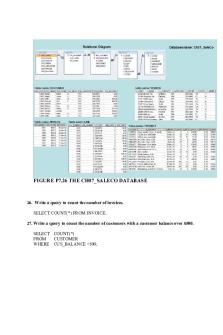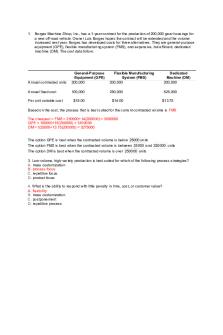Ch.7 notes from textbook PDF

| Title | Ch.7 notes from textbook |
|---|---|
| Author | Sophia Stella |
| Course | Introduction to the Business Value Chain |
| Institution | University of Maryland |
| Pages | 4 |
| File Size | 49 KB |
| File Type | |
| Total Downloads | 104 |
| Total Views | 189 |
Summary
An outline of the chapter from the class' required textbook. The notes aided in homework that was connected to the chapter....
Description
Managers roles are evolving - Managers must practice the art of getting things done through organizational resources such as workers, financial resources, information, and equipment - Today most managers try to be collaborative - Emphasize team building - They tend to guide, train, support, motivate, and coach employees rather than tell them what to do - Managers are necessary for communicating strategy, helping employees prioritze projects, facilitating cooperation, and ensuring that processes and systems aligned with company goals - Managers need the skills of communication, adaptability, foreign language skills The four functions of management - Management - the process used to accomplish organizational goals through planning, organizing, leading, and controlling people and other organizational resources - Planning - includes anticipating trends and determining the best strategies and tactics to achieve organizational goals and objectives - Planning is a key management function because accomplishing the other functions depends heavily on having a good plan - Organizing - designing the structure of the organization and creating conditions and systems in which everyone and everything work together to achieve the organization's goals and objectives - Leading - creating a vision for the organization and communicating, guiding, training, coaching, and motivating other to achieve goals and objectives ina timely manner - Controlling - measuring whether what actually occurs meets the organizations goals - establishes clear standards to determine whether an organization is progressing toward its goals and objectives, rewarding people for doing a good job, and taking corrective action if they are not. Planning and decision making - Vision - more than a goal; its a broad explanation of why the organization exists and where it’s trying to go. It gives the organization a sense of purpose and a set of values that unite workers in a common destiny - Mission statement - outlines the organizations fundamental purposes. - It should address: - The organizations self concept - Its philosophy - Long-term survival needs - Customer needs - Social responsibility - Nature of the product or service - Goals - the board, long term accomplishments an organization wishes to attain. - Often a team process - Objectives - specific, short term statements detailing how to achieve the organizations
goals. SWOT analysis - analyzes the organization's strengths and weaknesses, and the opportunities and threats are often external to the firm and cannot always be anticipated - Strategic planning - done by top management and determines the major goals of the organization and the policies, procedures, strategies, and resources it will need to achieve them. - Policies are broad guidelines for action - Strategies determine the best way to use resources - Tactical planning - process of developing detailed, short-term statements about what is to be done, who is to do it, and how - Managers at lower levels of business normally make this plan - Setting budgets, deciding on other activities necessary to meet strategic objectives - Operational planning - process of setting work standards and schedules necessary to implement the company's tactical objectives. - Focuses on specific supervisors, department managers, and individual employees. - Department managers tool for daily and weekly operations - Contingency planning - process of preparing alternative courses of action the firm can use if its primary plan don't work out. - Crisis planning - Decision making: finding the best alternative - Decision making - choosing among two or more alternatives, which sounds easier than it is. In fact decision making is the heart of all the management functions - Rational decision making - Define the situation - Describe and collect needed info - Develop alternatives - Decide which alternative is best - Do what is indicated - Determine whether the decision was a good one and follow upi - Problem solving - a less formal than decision making and usually calls for quicker action to resolve everyday issues - Brainstorming - coming up with as many solutions as possible ina short period of time with no censoring of ideas Organizing : creating a unified system - Top management - the highest level, sonsits of the president and other key company executives who develop strategic plans. Job titles and abbreviations you’re likely to see often are chief executive officer (CEO), chief operating officer (COO), chief financial officer (CFO), and chief information officer (CIO) - Middle management - includes general managers, division managers, and branch and plant managers (in college, deans and department head) who are responsible for tactical planning and controlling -
-
Supervisory management - includes those directly responsible for supervising workers and evaluating their daily performance; they're often known as first-line managers (supervisors) because they're the first level above workers Tasks and skills at different levels of management - Technical skills - the ability to perform tasks in a specific discipline or department - Human relation skills - - communication and motivations; they enable managers to wokr through and with people. Communication can be difficult when managers and employees speak different languages. Skills associated with leadership - coaching, morale building, delegating, training and development, and supportiveness - are also human relation skills - Conceptual skills - let the manager picture the organization as a whole and see the relationships among its various parts. They are needed in planning, organizing, controlling, systems development, problem analysis, decision making, coordinating, and delegating Staffing: getting and keeping the right people - Businesses need to provide incentives for employees to want to work there and stay there - Staffing 0 recruiting, hiring, motivating, and retaining the best people available to accomplish the company's objectives leading : providing continuous vision and values - Managers strive to produce order and stability, whereas leaders embrace and manage challenge. - Leadership is creating a vision for others to follow, establishing corporate values and ethics, and transforming the way the organization does business inn order to improve its effectiveness and efficiency - Good leaders motivate workers and create environments for them to mivetiate themselves - Establish corporate values - Concerns for everyone - Promote corporate ethics - Unfailing demand for honesty and an insistence that everyone in the company gets treated fairly - Transparency - the presentation of a company's facts and figures in a way that is clear and apparent to all stakeholders - Autocratic leadership - making managerial decisions without consulting others. - This style is effective in emergencies when absolute fellowship is needed - Participative ( democratic ) leadership - involves managers and employees working together to make decisions - Employee participation in decisions may not always increase effectiveness, but it usually creates job satisfaction - Free rein leadership - managers set objectives and employees are free to do whatever is appropriate to accomplish those objectives - Often most successful leadership style Empowering workers
-
Empowerment - giving employees the authority to make a decision without consulting the manager and the responsibility to respond quickly to consumer requests - Enabling - giving workers the education and tools they need to make decisions - Key to empowerment Managing knowledge - “Knowledge is power” - Empowering employees means giving them knowledge - Knowledge management - finding the right information, keeping it ina readily accessible place, and making it known to everyone in the firm together Controlling : making sure it works - Controlling consists of 5 steps - Establishing clear performance standards - Ties the planning function to the control function - monitoring and recording actual performance or results - Comparing results against plans and standards - Communicating results and deviations to the appropriate employees - Taking corrective action when needed and providing positive feedback for work well done A key criterion for measurement : customer satisfaction - External customers - include dealers, who buy products to sell others, and ultimate customers such as the general public, who buy products for their own personal use - Internal customers - individuals and units within the firm that receive services from other individuals or units....
Similar Free PDFs

Equity Notes from Textbook
- 25 Pages

AST1002 Notes from Textbook
- 30 Pages

Ch.7 notes from textbook
- 4 Pages

Week 7 notes from textbook
- 26 Pages

Ch. 18 notes from textbook
- 3 Pages

Week 6 notes from textbook
- 22 Pages

Chapter 5 - From textbook
- 7 Pages

Ch7 - Ch7
- 11 Pages

Test bank from the textbook
- 13 Pages

SE10-Solutions Manual from textbook
- 104 Pages

Ch7
- 4 Pages

AIS-notes- textbook notes
- 15 Pages

ACCT230 Ch7 - Lecture notes 5
- 60 Pages
Popular Institutions
- Tinajero National High School - Annex
- Politeknik Caltex Riau
- Yokohama City University
- SGT University
- University of Al-Qadisiyah
- Divine Word College of Vigan
- Techniek College Rotterdam
- Universidade de Santiago
- Universiti Teknologi MARA Cawangan Johor Kampus Pasir Gudang
- Poltekkes Kemenkes Yogyakarta
- Baguio City National High School
- Colegio san marcos
- preparatoria uno
- Centro de Bachillerato Tecnológico Industrial y de Servicios No. 107
- Dalian Maritime University
- Quang Trung Secondary School
- Colegio Tecnológico en Informática
- Corporación Regional de Educación Superior
- Grupo CEDVA
- Dar Al Uloom University
- Centro de Estudios Preuniversitarios de la Universidad Nacional de Ingeniería
- 上智大学
- Aakash International School, Nuna Majara
- San Felipe Neri Catholic School
- Kang Chiao International School - New Taipei City
- Misamis Occidental National High School
- Institución Educativa Escuela Normal Juan Ladrilleros
- Kolehiyo ng Pantukan
- Batanes State College
- Instituto Continental
- Sekolah Menengah Kejuruan Kesehatan Kaltara (Tarakan)
- Colegio de La Inmaculada Concepcion - Cebu


